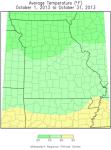COLUMBIA, Mo. – In 1937, animator Frank Tashlin borrowed the name of petunia for Porky Pig’s girlfriend. Just as animation has changed greatly in nearly 80 years, today’s petunia is a far cry from yesteryear’s flower.
“Years ago when Petunia Pig was first named, petunias were nonhybrids, rank in growth, floriferous in season and suffered from ‘summer swoon,’ meaning they reacted very poorly to the heat of summer,” said David Trinklein, horticulture specialist for University of Missouri Extension.
Trinklein says crossbreeding unrelated seed lines has greatly improved the petunia. Today’s petunias are much more compact and free-flowering, giving them a more pleasing structure and appearance.
Most importantly for Midwesterners, today’s varieties can put up with the heat of summer, Trinklein said. Modern petunias are showy in a multitude of colors and color combinations, and will flower continuously throughout the growing season until the first hard frost.
Many of the new generation petunias are clones.
“There are companies that will cross petunias and select from those crosses superior individuals that are not yet genetically stable, so they cannot be seed-propagated. They have to be maintained as vegetative clones,” Trinklein said.
For example, Surfinia, Potunia and Supertunia are all examples of vegetatively propagated petunia brands, he said. In the case of the latter, a new level was set with the development of Supertunia Vista Bubblegum.
“First of all, you better like the color pink, because you’re going to get it,” Trinklein said. “It’s like a petunia on steroids. You see nothing but flowers from the time you put them out until frost knocks them out. It’s an amazing accomplishment.”
However, vegetatively propagated petunias are a bit more expensive.
“Gardeners have learned that their performance is so superior that it usually takes fewer of them,” he said. “They thrive even in the brutal heat of summer, so they may be worth the expense.”
If you prefer growing the plants from seeds, there are new and better seed-propagated varieties available. Ball Seed has the Wave series, he said. They are almost as heat-tolerant as the vegetatively propagated varieties and much more compact than earlier seed varieties. They are also less expensive.
Your grandparents could have only dreamed of the modern petunia. The myriad of horticultural advancements may have prompted the National Garden Bureau to name 2014 the Year of the Petunia.
“I think the National Garden Bureau wanted to call attention to the fact that if you haven’t grown petunia lately, it’s not the flower that you knew 25 years ago, so you ought to give it another try,” Trinklein said.
Sidebar:
Petunia petals
- Related to tobacco, tomatoes, deadly nightshades and potatoes.
- Derives its name from the Brazilian word “petun,” which means tobacco.
- Discovered in South America by explorer James Tweedie, who sent specimens to the Glasgow Botanic Gardens in 1831.
- Attracts both hummingbirds and moths.
- The flowers can be white, yellow, pink, purple, red and blue, as well as bicolor.
- It is semi-frost-hardy and able to withstand temperatures down to 26-28 degrees Fahrenheit.
- Petunia seeds are very tiny. If you want to grow your own plants from seeds, it’s best to start them in a light garden.
- In 2011 Ball Seed introduced a black petunia. Once the novelty wore off, its popularity declined. A black flower fades into obscurity in the garden.
- The common garden petunia carries the scientific name of Petunia x hybrida, indicating it is hybrid in origin.
- Classified into several flowering types:
- Grandiflora have large, heavily ruffled, individually ornate flowers.
- Multiflora have smaller, less ornate flowers, but more of them.
- Hedgiflora, or spreading, are low-growing plants that can be used as flowering ground cover.
- Floribunda utilizes the best traits of grandiflora and multiflora and comes in single- and double-flowered.
- Milliflora are about two-thirds the size of a normal petunia and flower abundantly.
- Petunias are typically 2-4 inches in diameter and 3 inches in length.
- The tallest of the petunias might be Tidal Wave. They can grow 24-30 inches tall.
- Will flourish in full sun as long as you keep them well-watered.
- They will grow in partial shade, but won’t flower as much and the stems will stretch more.
- Can be used in beds or borders, as edging or ground cover. Will grow in containers, window boxes and hanging baskets.
Read more http://extension.missouri.edu/news/DisplayStory.aspx?N=2161






